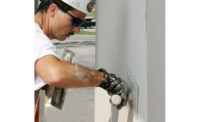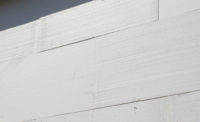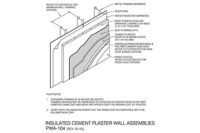Without question, you are the expert. For years you have specified, detailed, manufactured, ordered, stocked, delivered or installed Continuous Insulation. Right now, you are saying, “I have?” I can explain.
Exterior insulation finish system, as you know, is a wonderful system that’s been used worldwide on hundreds of thousands of projects, covering millions of square feet. EIF systems are easy to design. They’re very durable when properly specified and installed, according to the manufacturers specifications. They also obtain a beautiful look with the use of EPS shapes that are cut easily using CNC hot wire machines.
EIFS took off in North America during the energy crisis back in the 1970s. EIFS made its debut in the United States after decades of successful use in Europe. Folks in the U.S. were suddenly looking for ways to increase the energy efficiency of their new homes and commercial buildings as well as for upgrading existing projects. What better product is there to use other than EIFS?
With the use of acrylic adhesives and mechanical fasteners, virtually any substrate is a great attachment point for EIFS. Owners of EIFS projects realize the base layer of expanded polystyrene provides a cozy dwelling that is also very energy efficient. Designers love EIFS because it is lightweight and customizable, due to the fact that almost any shape can be detailed.
Therefore, in a sense you’ve been installing CI and then going on to add base coat, mesh and finish.
What is CI?
I’ve been asked this question frequently. It’s an exterior layer of insulation such as expanded polystyrene EPS, extruded polystyrene XPS, polyisocyanurate or polyurethane spray foams. It runs continuously over structural members, regardless of what the exterior cladding is, and is free from significant thermal bridging. Sounds a lot like EIFS, right? It’s just missing the acrylic base coat, impact mesh and acrylic finish.
EIFS is our Heritage, CI is the Future
I’ve heard some general contractors say that they might get unskilled labor to install CI thinking it’s not an important element of the wall assembly. This could not be further from the truth.
Most of those in the EIFS trade know the importance of running bond foam joints and tight joints to protect against thermal breaks; this is also true with CI. It has been acknowledged that the use of quality, third-party-tested fasteners is critical to the EIF system. That does not differ here. Coated screws that meet ASTM B117 should be used to avoid the risk of rust bleed through, or even complete rust out and failure of the screw causing the foam to let go of the substrate.
To Glue or Screw?
Mechanical fasteners and adhesive applications of foam each have their own pros and cons. Proper application of the fastener, washer or plate, whatever you call it in your neck of the woods, is just as critical for CI as it is for EIFS. Overdriving the fastener deeply into the foam will weaken the foam attachment and make it prone to negative wind load pull off. The use of a Depth Stop will be a great asset when setting fasteners.
Weather Permitting
When using any type of adhesive, failure to use the correct amount or doing so under extreme weather conditions will cause failure on site. Cooler temperatures create longer cure times while hot weather speeds up the process. Extreme humidity also adds to your adhering challenge by causing longer set times. Finally, adhesives tend to have a short shelf life so you’ll need to ensure the applicator is using products within their usage dates. The good news is mechanical fasteners bridge these issues making them a preferred product for all weather conditions.
Some are advocating an adhesive only attachment for CI citing “potential visual effects.” Do not be misled by this opinion. Together, both fasteners and adhesives create the best solution for your EIFS and CI applications but if you have to choose one over the other, mechanical fasteners will check every box.
Spray foams require specialized equipment such as one called the Poly-Plane to knock down and smooth out the high spots prior to the substrate application. These products, tools and techniques may be new to many of you in the EIFS business; the tools and advice can be found at some of the places you find your EIFS tools.
CI Checks all the Boxes
CI is a major source of revenue and a great opportunity for our industry. As experts in this industry, you have installed foam on substrates, provided the materials needed, set up scaffolding and installed fasteners to attach the foam. You’ve gone on to use Hot Knifes and Hot Wire Tables to cut the foam and have installed thousands of fasteners into EPS and rasped the walls smooth.
CI is your trade and you are the experts. Just like you have claimed EIFS and stucco, claim and embrace CI. At the same time, I’ll bet with a little persuasion you can upsell EIFS to owners and designers who might have been thinking of a different exterior cladding.
I recall my days as a distributor, scouring job plans and specs looking for any and every product we supplied so we could get on that job and provide leads to our contractors. How nice it would have been to look at every metal framed building knowing we could supply products to all of those projects no matter what the exterior cladding would be. Folks, this is a great time to be working in our industry.
Foam Manufacturers, you are experts by manufacturing EPS, XPS, polyiso, spray foam and other types of foam that are required. These foams have years of applied technology and testing as well as keeping up with and exceeding all the ASTM’s and code requirements. All the while meeting delivery requirements that your distributors need to keep their contractors’ jobs stocked.
CI/EIFS suppliers: you are the experts supplying the tools, fasteners and required products needed to get the job done. You supply scaffolding, fasteners, hot knifes, rasps, trowels, drills, tarps, tape, adhesives and all things required to support the distributor and contractors.
EIFS distributors: you are the expert suppliers. Every day you juggle the needs and requirements of your contractors, work with your manufacturers to solve logistic issues, meet with architects to get your products specified then make sure your contractors have the bid information they need. Pressures of delivery deadlines, shortages and labor problems all seem to fade away at the end of the day when you know your contractors’ job is stocked and ready for their crew the next day. Who are we kidding: dropped off at the job site and on the wall that same day.
EIFS manufacturers: you are the experts that put all the components together. The testing you employ to be sure of component integration, R&D, wind load testing, finish durability, fire testing, impact resistance, attachment protocols and design requirements makes you the gatekeeper. Bumps along the way, sure, but we all know EIFS is a wonderful, durable system.
Contractors: you are the experts in application. You have the work force, the tools and the insurance. Wow, that alone is enough to drive the faint of heart to start bagging groceries for a living. Every day you bid jobs, sometimes low enough where you wonder how you are going to make payroll and send a check to your distributor. You’re always concerned about keeping your bottom line in the black. Dealing with jobs that have been delayed, MIA laborers, price increases, OSHA visits, the list goes on. At the end of the job, you deliver a great product and are proud of what you turned out.
As experts in the fields of EIFS and CI, I would encourage you to embrace CI as much as the first generation of EIFS guys did when they heard about putting a plaster/stucco like product over foam on the outside of buildings. Let’s show the other trades that CI is our business and that we aren’t giving it up to them.










Report Abusive Comment